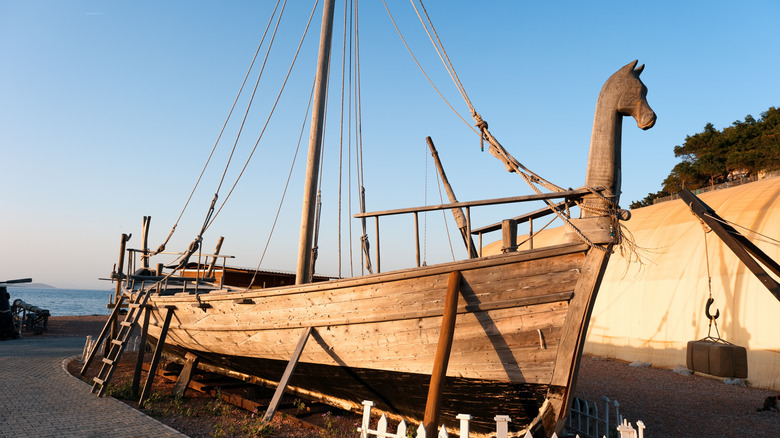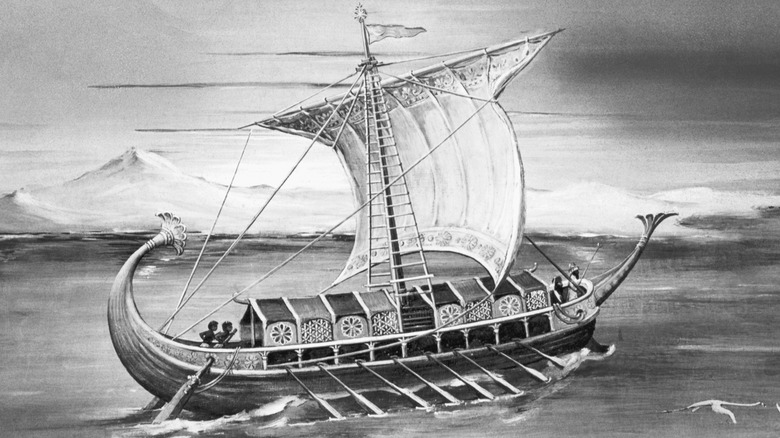The Revolutionary Naval Innovations That Helped The Phoenicians Conquer The Ancient Mediterranean
When you think of famous BCE-era civilizations, some that immediately spring to mind are probably the Ancient Greeks, Ancient Egyptians, and other such societies that flourished around the Mediterranean Sea. However, there was one particular civilization that, while not as overtly well-known as some others, still had an incredibly vital impact on global societal development, well up into the modern day: the Phoenicians, also known as the Canaanites.
The Phoenicians' major claim to fame was their incredible maritime prowess. As far back as 3,000 BCE, the Phoenicians' seafaring skills and innovations gave them the ability to explore and trade far beyond the confines of their home, reaching out and touching other burgeoning societies across the Mediterranean. Their influence was so pronounced, that the primary records historians rely on to study them today were actually penned largely by Ancient Greek and Assyrian scholars. The Phoenicians' naval innovations were varied and fascinating, though if there were just two we could highlight, it would be their invention of the first true keels and their use of revolutionary navigational techniques.
Phoenicians developed the first true keels to be used on boats
The keel is one of the oldest, most important components to ever be incorporated into a seafaring vessel. It's a long ridge that runs across the entire bottom of a boat, almost like a spine, and is chiefly responsible for keeping the boat steady on the water. That extra steadiness also helps make the boat easier to steer.
Technically, the concept was originally developed back in Ancient Egypt and Mesopotamia, but these keels were relatively primitive and only attached to simple reed and riverboats. The first true keel, one intended for a seafaring vessel, was conceptualized by the Phoenicians. They would attach a single, lengthy piece of timber to the bottom of the boat, creating a focal point that keeps the ship balanced and sailing straight. The extra stability afforded by these keels allowed Phoenician ships to stay steady even on the choppy waters of the open ocean, making long-distance, coast-to-coast travel much safer.
Even in the modern day of maritime travel, the keel remains of the utmost importance. Sailboats still use fixed keels to stay steady, but motorboats employ retractable keels, whose elevation can be adjusted on the fly to navigate deeper or shallower waters. A particular offshoot of keels is the skeg, which includes a frame to protect a motorboat's rear rotor mechanism. Even massive Navy vessels are kept afloat largely by their keels.
Phoenician sailors were some of the first to navigate with the stars and dead reckoning
In addition to their prowess in building newer and better ships, Phoenicians were also quite skilled at piloting their creations. You can find references to Phoenician navigational skills in ancient texts penned by scholars and storytellers like Herodotus and Homer.
Two of the most revolutionary techniques employed by Phoenician sailors were celestial navigation and dead reckoning. Celestial navigation is the practice of finding your way with the help of the stars and constellations in the night sky; the Phoenicians are believed to be one of the earliest societies to employ celestial navigation in maritime travel. By simply gauging the angles between two familiar stars in the night, sailors could determine their rough coordinates. Dead reckoning, meanwhile, involved making an educated guess of a vessel's current position based on how quickly it was sailing, how long it had been sailing for, and the direction it was sailing in. This was vital in instances where clear landmarks couldn't be seen from the vessel.
Both of these techniques would become common use for sailors all over the world in subsequent centuries; Homer's epic poem, the Odyssey, makes extensive note of constellations for navigation purposes. As for dead reckoning, that simple framework of estimation would be refined further through the circulation of new innovations like the European Traverse Board, as well as in the form of chip logs and measurement in knots, the latter of which persists as a part of maritime navigation procedure to this day.


